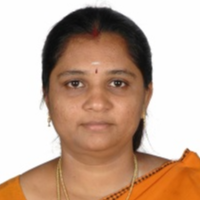
Kalaiselvi T
Work place: Department of Computer Science and Applications, The Gandhigram Rural Institute – Deemed University, Tamil Nadu, India
E-mail: kalaiselvi.gri@gmail.com
Website: https://orcid.org/0000-0002-0197-2077
Research Interests: Medical Image Computing, Image Processing, Image Manipulation, Image Compression
Biography
T. Kalaiselvi is currently working as an Assistant Professor in Department of Computer Science and Applications, The Gandhigram Rural Institute, Dindigul, Tamilnadu, India. She received her Bachelor of Science (B.Sc) degree in Mathematics and Physics in 1994 & Master of Computer Applications (M.C.A) degree in 1997 from Avinashilingam University, Coimbatore, Tamilnadu, India. She received her Ph.D degree from The Gandhigram Rural University in February 2010. She has completed a DST sponsored project under Young Scientist Scheme. She was a PDF in the same department during 2010-2011. An Android based application developed based on her research work has won First Position in National Student Research Convention, ANVESHAN-2013, organized by Association of Indian Universities (AUI), New Delhi, under Health Sciences Category. Her research focuses on MRI of human Brain Image Analysis to enrich the Computer Aided Diagnostic process, Telemedicine and Teleradiology Technologies.
Author Articles
Three Dimensional Rapid Brain Tissue Segmentation with Parallel K-Means Clustering Using Graphics Processing Units
By Kalaichelvi N. Sriramakrishnan P. Kalaiselvi T Saleem Raja A.
DOI: https://doi.org/10.5815/ijem.2025.03.02, Pub. Date: 8 Jun. 2025
Virtual reality plays a major role in medicine in the aspect of diagnostics and treatment planning. From the diagnostics perspective, automated methods yields the segmented results into virtual environment which will helps the physician to take accurate decisions on time. Virtual reality of 3D brain tissue segmentation helps to diagnostic the brain related diseases like alzheimer's disease, brain malformations, brain tumors, cerebellar disorders and etc. The work proposed a fully automatic histogram-based self-initializing K-Means (HBSKM) algorithm is performed on compute unified device architecture (CUDA) enabled GPU (QudroK5000) machine to segmenting the human brain tissue. Number of clusters (K) and initial centroids (C) automatically calculated from the mid image from the volume through Gaussian smoothening technique. The experimental dataset was collected from internet brain segmentation repository (IBSR) in segmenting the three major tissues such as grey matter (GM), white matter (WM) and cerebrospinal fluid (CSF) to experiment the efficiency of the present parallel K-Means algorithm. Computation time is calculated between the homogenous and heterogeneous environment of CPU and GPU for HBSKM algorithm. This proposed work achieved 6× speedup folds while heterogeneous CPU and GPU implementation and 3.5× speedup folds achieved with homogenous GPU implementation. Finally, volume of segmented brain tissue results was presented in virtual 3D and also compared with ground truth results.
[...] Read more.Automatic Brain Tissues Segmentation based on Self Initializing K-Means Clustering Technique
By Kalaiselvi T Kalaichelvi N Sriramakrishnan P
DOI: https://doi.org/10.5815/ijisa.2017.11.07, Pub. Date: 8 Nov. 2017
This paper proposed a self-initialization process to K-Means method for automatic segmentation of human brain Magnetic Resonance Image (MRI) scans. K-Means clustering method is an iterative approach and the initialization process is usually done either manually or randomly. In this work, a method has been proposed to make use of the histogram of the gray scale MRI brain images to automatically initialize the K-means clustering algorithm. This is done by taking the number of main peaks as well as their values as number of clusters and their initial centroids respectively. This makes the algorithm faster by reducing the number of iterations in segmenting the MRI image. The proposed method is named as Histogram Based Self Initializing K-Means (HBSIKM) method. Experiments were done with the MRI brain volumes available from Internet Brain Segmentation Repository (IBSR). Similarity validation was done by Dice coefficient with the available gold standards from the IBSR website. The performance of the proposed method is compared with the traditional K-Means method. For the IBSR volumes, the proposed method yields 3 to 4 times faster results and higher dice value than traditional K-Means method.
[...] Read more.An Automatic Segmentation of Brain Tumor from MRI Scans through Wavelet Transformations
DOI: https://doi.org/10.5815/ijigsp.2016.11.08, Pub. Date: 8 Nov. 2016
Fully automatic brain tumor detection is one of the critical tasks in medical image processing. The proposed study discusses the tumor segmentation process by means of wavelet transformation and clustering technique. Initially, MRI brain images are preprocessed by various wavelet transformations to sharpen the images and enhance the tumor region. This helps to quicken the clustering technique since tumor region appears good in sharpened CSF region. Finally, a wavelet decomposition method is applied in CSF region and extracts the tumor portion. This proposed method analyzes the performance of various wavelet types such as Haar, Daubechies (db1, db2, db3, db4 and db5), Coiflet, Morlet and Symlet in MRI scans. Experiments with the proposed method were done on 5 volume datasets collected from the popular brain tumor pools are BRATS2012 and whole brain atlas. The quantitative measures of results were compared using the metrics false alarm (FA) and missed alarm (MA). The results demonstrate that the proposed method obtaining better performance in the terms of both quantity and visual appearance.
[...] Read more.Other Articles
Subscribe to receive issue release notifications and newsletters from MECS Press journals